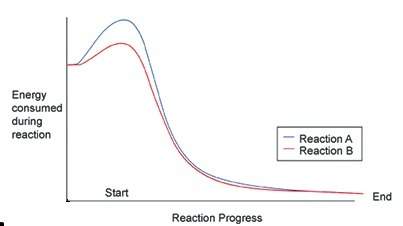
Biology, 20.10.2019 21:00 rogersdeloris1ovgm3b
How does the activation energy differ between reactions a and b, which are both enzyme-catalyzed reactions?
choices:
a. reaction a has a lower activation energy than reaction b
b. reaction a has a higher actvation energy than reaction b
c. reaction a & b have the same activation energy.
d. reaction a & b don't require activation energy.
i think it's option b but i'm not sure.


Answers: 1


Another question on Biology

Biology, 22.06.2019 01:10
Which of the following is a difference between active transport and facilitated diffusion? view available hint(s)which of the following is a difference between active transport and facilitated diffusion? facilitated diffusion can move solutes against a concentration gradient, and active transport cannot.active transport involves transport proteins, and facilitated diffusion does not.facilitated diffusion involves transport proteins, and active transport does not.active transport requires the expenditure of cellular energy, and facilitated diffusion does not.
Answers: 1

Biology, 22.06.2019 06:30
Genetic disorders can result when sister chromatids fail to seperate properly. during what phase is this problem most likely to occur?
Answers: 3

Biology, 22.06.2019 16:30
Clara wrote the following hypothesis for an experiment about acidophilic bacteria. bacteria cells will stop dividing in a basic (alkaline) environment because of the high ph. which statement is the best way to restate the hypothesis so that it is more specific? growing acidophilic bacteria in some environments will cause the cells to stop dividing because of ph. if the ph of their environment is changed, acidophilic bacterial cell division will be affected. if the environment of acidophilic bacterial cells becomes alkaline, the bacteria will stop dividing. the more alkaline an environment, the less cell division will occur in bacteria.
Answers: 1

Biology, 22.06.2019 17:30
98 points you will be galileo perform the experiment to determine if objects with different mass fall at the same, or different, rates in the air and in a vacuum. before you conduct your experiment, you need to form a hypothesis. a hypothesis is a prediction of what you think will happen in the experiment. the hypothesis is a statement that describes “if” a certain set of circumstances are present “then” there will be a specific result that will occur. record your hypothesis here: record the results from step one of the experiment (dropping the objects in the air): first trial: second trial: third trial: record the results from step two of the experiment (dropping the objects in a vacuum): first trial: second trial: third trial: did the experiment support your hypothesis? using the data from your experiment, describe why you believe your hypothesis was either proven or disproven. what forces were acting on the objects dropped in the air? what force was acting on the objects dropped in the vacuum? part two: comparing forces choose two forces and compare and contrast these forces. you must provide two ways that they are alike and two ways that they are different. you may make a list, write in paragraph form, or make a chart. choose two forces and compare and contrast these forces. these must be different forces than used in the prior question. provide two ways that they are similar and two ways that they are different. you may make a list, write it out, or make a chart.
Answers: 1
You know the right answer?
How does the activation energy differ between reactions a and b, which are both enzyme-catalyzed rea...
Questions

Geography, 10.02.2021 21:20


Mathematics, 10.02.2021 21:20





History, 10.02.2021 21:20


Mathematics, 10.02.2021 21:20

Health, 10.02.2021 21:20

Mathematics, 10.02.2021 21:20

Mathematics, 10.02.2021 21:20


Arts, 10.02.2021 21:20

Mathematics, 10.02.2021 21:20



Mathematics, 10.02.2021 21:20

Mathematics, 10.02.2021 21:20




